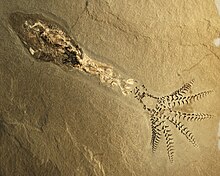Belemnoidea
| Belemnoids Temporal range: Devonian–Cretaceous |
|
|---|---|
 |
|
| Well preserved Phragmoteuthis conocauda, showing arm hooks and outline of mantle | |
| Scientific classification | |
| Kingdom: | Animalia |
| Phylum: | Mollusca |
| Class: | Cephalopoda |
| Superorder: | Decapodiformes |
| Clade: | †Belemnoidea |
| Orders | |
Aulacocerida
Phragmoteuthida
Belemnitida
Diplobelida
Belemnoids are an extinct group of marine cephalopod, very similar in many ways to the modern squid and closely related to the modern cuttlefish. Like them, the belemnoids possessed an ink sac, but, unlike the squid, they possessed ten arms of roughly equal length, and no tentacles. The name "belemnoid" comes from the Greek word βέλεμνον, belemnon meaning "a dart or arrow" and the Greek word είδος, eidos meaning "form".
Belemnoids include belemnites (which belong to order Belemnitida proper), aulacocerids (order Aulacocerida), phragmoteuthids (order Phragmoteuthida), and diplobelids (order Diplobelida).
Belemnoids were numerous during the Jurassic and Cretaceous periods, and their fossils are abundant in Mesozoic marine rocks, often accompanying their cousins the ammonites. The belemnoids become extinct at the end of the Cretaceous period along with the ammonites. The belemnoids' origin lies within the bactritoid nautiloids, which date from the Devonian period; well-formed belemnoid guards can be found in rocks dating from the Mississippian (or Early Carboniferous) onward through the Cretaceous. Other fossil cephalopods include baculites, nautiloids and goniatites.
...
Wikipedia
